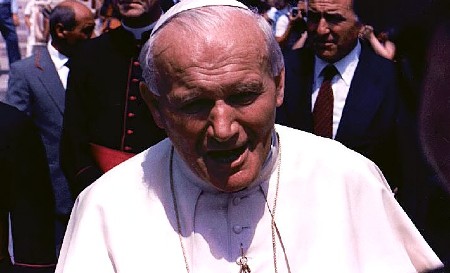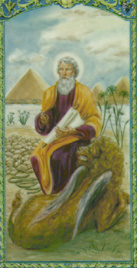We ask you, humbly: don't scroll away.
Hi readers, it seems you use Catholic Online a lot; that's great! It's a little awkward to ask, but we need your help. If you have already donated, we sincerely thank you. We're not salespeople, but we depend on donations averaging $14.76 and fewer than 1% of readers give. If you donate just $5.00, the price of your coffee, Catholic Online School could keep thriving. Thank you.Help Now >
Month of May, Month of Mary: God Bearer, First Disciple and Pilgrim
FREE Catholic Classes
Mary's response to the invitation of the God who respects human freedom is an invitation to each one of us to explore our own personal histories and to write them anew in Him. We do this by exercising our own freedom. By saying Yes to Jesus. By choosing to live the more excellent way of love. Mary walked this way with extraordinary humility. (1 Cor. 12:31) She shows us the pattern of human love surrendered to Divine Love.
Highlights
Catholic Online (https://www.catholic.org)
5/7/2013 (1 decade ago)
Published in Europe
Keywords: Mary, Marian, Mother of God, Rosary, May, May crowning, piety, Pope Francis, Confraternity, Deacon Keith Fournier
P>CHESAPEAKE, VA (Catholic Online) - In many cultures which have been influenced by the culture of the Catholic Church, the Month of May has become especially associated with honoring Mary, the Mother of the Lord Jesus. As in many aspects of Catholic culture, grace builds upon nature.
May is the beginning of spring which is a sign and symbol of new life, as the barrenness of winter comes to an end and new life begins to break forth. Mary is the Mother of the One through whom our New Life has come. Jesus, her Son, is the first born of the New Creation. (Col. 1:15)
In spite of the Rain, thousands of Pilgrims gathered. Pope Francis celebrated Mass outside in St Peters Square. At the end of Mass he led the faithful in reciting the Regina Caeli, an ancient popular Marian prayer in the Catholic Church. Practices of popular piety have flourished during the month of May which express special affection and honor toward Mary.
Included in the crowd were leaders from lay confraternities around the world. Confraternity is a word used to describe some of the multiple lay groups in the Catholic Church which the Holy Spirit is raising up or renewing for this new missionary age. They often have a special devotional life and live missionary vocations in the midst of the real world.
Pope Francis made these comments about Mary as pilgrim and model for all Christians: "In this moment of profound communion in Christ, we feel the spiritual presence of the Virgin Mary alive in our midst - a maternal presence, a familiar presence, especially for you are taking part in the Confraternities. The love for the Madonna is one of the characteristics of popular piety, which needs to be strengthened and well oriented."
"For this reason, I invite you to meditate on the last chapter of the Constitution of the Second Vatican Council on the Church, Lumen Gentium, which speaks precisely of Mary in the mystery of Christ and of the Church. There it is said that Mary "advanced in her pilgrimage of faith" (n. 58). Dear friends, in the Year of Faith I leave you this icon of Mary the pilgrim, who follows Jesus the Son, and goes before all of us in the journey of faith."
"Today the Eastern Churches that follow the Julian Calendar celebrate the feast of Easter. I wish to send to these brothers and sisters a special greeting, uniting myself to them with all my heart in proclaiming the joyful news: Christ is risen!"
"Gathered in prayer around Mary, we ask God for the gift of the Holy Spirit, the Paraclete - that He might counsel and comfort all Christians, especially those who celebrate Easter amongst trials and sufferings, and might guide them in the ways of reconciliation and peace."
Special love and devotion toward Mary is woven into Catholic piety and culture. It is also a vital part of Orthodox Christianity. Because it is so naturally supernatural to many of us, we can sometimes forget that some other Christians, particularly members of groups which descend from the Protestant Reformation in Europe, do not understand our practices.
We ask you, humbly: don't scroll away.
Hi readers, it seems you use Catholic Online a lot; that's great! It's a little awkward to ask, but we need your help. If you have already donated, we sincerely thank you. We're not salespeople, but we depend on donations averaging $14.76 and fewer than 1% of readers give. If you donate just $5.00, the price of your coffee, Catholic Online School could keep thriving. Thank you.Help Now >
It is important to remember that these practices not only speak of Mary but, most importantly, they are profoundly Christological. Thay are also ancient in their theological roots.
Some of the leaders of the movement called the protestant reformation had a deep devotion to and love for Mary. For example, Martin Luther wrote the following words in his commentary on the "Magnificat". "Men have crowded all her glory into a single phrase: The Mother of God. No one can say anything greater of her, though he had as many tongues as there are leaves on the trees."
From the earliest centuries of Christianity Mary was called in Greek the Theotokos. The word means Mother of God or God-Bearer. The term was woven into the liturgical worship and popular piety of the undivided Church of the first millennium. This title was a response to the early threats to 'orthodoxy' by groups denying either the divinity or humanity of Jesus Christ. It was to protect the deposit of faith, to preserve authentic Christian doctrine.
From antiquity, Mary's special place in the plan of salvation was acknowledged by all Christians. In fact, the early Christians painted her image in the catacombs during their moments of fear, persecution and doubt. They found great inspiration from this little woman of great faith. In her yes to God's call, spoken through the Angel, they came to understand that ordinary people can change human history.
They were inspired to then add their own yes to hers. Justin Martyr and many other early Christian apologists found in her fiat, her obedient yes to the angel, the undoing of the "no-I will not serve" given by the first woman Eve. They called Mary The Second Eve, the mother of a new creation.
In her womb Mary carried the One whom Scripture calls the "New Adam" (1 Cor. 15:45). He was born from her as the first born of a new race of men and women who would find a new birth through His life, death and Resurrection. (1 Cor 15.27; 2 Cor 5.17; Col 1.15; ) The Redeemer now resides within, and lives through, all who respond to the invitation of Love like Mary did.
A pronouncement of an early Church Council, The Council of Ephesus, in 431 AD, insisted " If anyone does not confess that God is truly Emmanuel, and that on this account the holy virgin is the "Theotokos" (for according to the flesh she gave birth to the word of God become flesh by birth) let him be anathema."
The Greek term Theotokos, God-bearer or Mother of God is still the most popular title given to Our Lady in the Eastern Christian Churches, Catholic and Orthodox. It was affirmed in early Church Councils precisely because it confirmed the Christian claim about who Jesus Christ is - and who each one of us is invited to become as we cooperate with grace and live our lives in the Church which is His Body.
The reason for the insistence on this title was the teaching that Jesus Christ was - and is - both Divine and Human. The doctrine is Christological, meaning that it had to do with Jesus Christ. No one has ever claimed that Mary gave birth to Christ's Divinity, but rather, that His human and divine nature could not - and cannot - be separated.
Not only was this truth under assault then, it is under assault now. This teaching lies at the heart of the Christian claim concerning the implications of the Incarnation of Jesus Christ in each of our lives. It must be protected as the unique distinctive and contribution of Christianity.
Continued disagreements concerning this title, the Mother of God, have led to a diminution in the role of Mary in some Christian circles. Subsequent reaction and counter reactions have made it difficult to even discuss Mary in certain circles where Christians gather in common pursuits.
Sadly, this impedes some Christians from grasping the meaning of Mary's response to God's invitation, her role in the plan of salvation, her exemplary humility and her deference to God's Will. It has also clouded an important lesson for all Christians, Mary is the type, the living blueprint, of the Christian vocation for all who seek to follow Jesus Christ.
From the earliest centuries, there have been reflections on the last gift Jesus gave before the total gift of Himself on Golgotha. The beloved disciple records the moment. "When Jesus saw his mother, and the disciple whom he loved standing near, he said to his mother, "Woman, behold, your son!" Then he said to the disciple, "Behold, your mother!" And from that hour the disciple took her to his own home". (John 19:26, 27)
The writings of the early Christian Church fathers explain that this gift from Jesus to the beloved disciple John is also a gift to the whole Church - and to every member. Jesus gave us His Mother. The meaning and mystery of Mary is a gift to be opened and received, reflected upon, prayed over and lived.
Mary's response to the invitation of the God who respects human freedom is an invitation to each one of us to explore our own personal histories and to write them anew in Him. We do this by exercising our own freedom. By saying Yes to Jesus. By choosing to live the more excellent way of love. Mary walked this way with extraordinary humility. (1 Cor. 12:31) She shows us the pattern of human love surrendered to Divine Love.
When we live that way, Love Incarnate is revealed through each of us so that He can then be given to others through us. We can become God Bearers. Among the multiple references to Mary, the Mother of God, found in the writings of the early Church Fathers is one of my favorites from the Cappadocian Father, Gregory of Nyssa who died in 356 A.D:
"What came about in bodily form in Mary, the fullness of the godhead shining through Christ in the Blessed Virgin, takes place in a similar way in every soul that has been made pure. The Lord does not come in bodily form, for ´we no longer know Christ according to the flesh´, but He dwells in us spiritually and the Father takes up His abode with Him, the Gospel tells us. In this way the child Jesus is born in each of us."
The early fathers used other descriptive terms, rooted in the sacred scriptures, meant to further help us to unpack this mystery. For example, they called her the Ark of the new Covenant and the tent of meeting. We can become the tent and the ark within which God takes up His residence, comes to dwell, in our own age - which so desperately needs His saving presence.
Jesus still comes to dwell in all men and women who say Yes to Him. "Whoever loves me will keep my word, and my Father will love him, and we will come to him and make our dwelling with him." (John 14:23) We are invited to bear Jesus for others and invite them, through the waters of Baptism, into new birth in His Body, the Church.
The Catechism of the Catholic Church puts it this way,"What the Catholic faith believes about Mary is based on what it believes about Christ, and what it teaches about Mary illumines in turn its faith in Christ." (CCC#487) The Catholic Catechism also reminds us, "Mary's role in the Church is inseparable from her union with Christ and flows directly from it."(CCC #964)
It is time to re- examine the deeper implications of the treasure that is found in the life example and message of the little Virgin of Nazareth in this critical hour in human history. Mary, Mother of God is a virtual pilgrimage site inviting pilgrims to reflect on the mysteries of the faith, pray and encounter the most beautiful artwork from our history. It will also become a place where we pray together, and grow together.
Catholic Online offers "Mary, the Mother of God", a virtual pilgrimage site and repository of reflection, devotion, prayer and beauty dedicated to honoring the Mother of God. It is a place for all those who want to be drawn more deeply into a saving and transformational relationship with Her Son and Savior Jesus Christ. May it be a blessing to you durung the month of May, the month of Mary.
---
'Help Give every Student and Teacher FREE resources for a world-class Moral Catholic Education'
Copyright 2021 - Distributed by Catholic Online
We ask you, humbly: don't scroll away.
Hi readers, it seems you use Catholic Online a lot; that's great! It's a little awkward to ask, but we need your help. If you have already donated, we sincerely thank you. We're not salespeople, but we depend on donations averaging $14.76 and fewer than 1% of readers give. If you donate just $5.00, the price of your coffee, Catholic Online School could keep thriving. Thank you.Help Now >









 Daily Readings for Thursday, April 25, 2024
Daily Readings for Thursday, April 25, 2024 St. Mark: Saint of the Day for Thursday, April 25, 2024
St. Mark: Saint of the Day for Thursday, April 25, 2024 Prayer for Policemen: Prayer of the Day for Thursday, April 25, 2024
Prayer for Policemen: Prayer of the Day for Thursday, April 25, 2024

